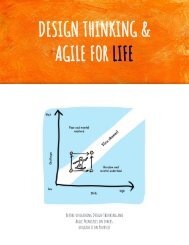2020 iLEAD e-book
- No tags were found...
Create successful ePaper yourself
Turn your PDF publications into a flip-book with our unique Google optimized e-Paper software.
The Leadership Continuum<br />
In 1938, Lewin and Lippitt proposed classifications of leaders. These were based on how much involvement<br />
leaders placed onto task and relationship needs. These types of leadership behaviour were expressed in 1973,<br />
along a Leadership Continuum by Tannenbaum & Schmidt. The spectrum ranges from boss-‐centred (task) to<br />
subordinate-‐centered (relationship).<br />
To choose the most appropriate style, the leader should take into consideration:<br />
1. Manager: belief in team member participation and confidence in capabilities of members.<br />
2. Subordinates: subordinates who are independent, tolerant of ambiguity, competent, identify<br />
with organizational goals.<br />
3. Situation:<br />
o the team has requisite knowledge.<br />
o the team has organizational values and traditions.<br />
o the team works effectively.<br />
4. Time pressure: need for immediate decision under pressure. Mitigates against participation<br />
ADVANTAGES OF THE LEADERSHIP CONTINUUM MODEL<br />
Gives managers a range of choices for involvement<br />
Presents criteria for involvement and delegation<br />
Focuses the decision maker on relevant criteria<br />
Emphasizes employee development and empowerment<br />
LIMITATIONS OF THE LEADERSHIP CONTINUUM MODEL<br />
Involves only the initial step of assigning a task to someone, not the subsequent processes that<br />
may determine the effectiveness of the outcome.<br />
Assumes that the manager has sufficient information to determine the disposition to himself or<br />
to the team.<br />
Assumes "neutral" environment without social bonds or politics

















